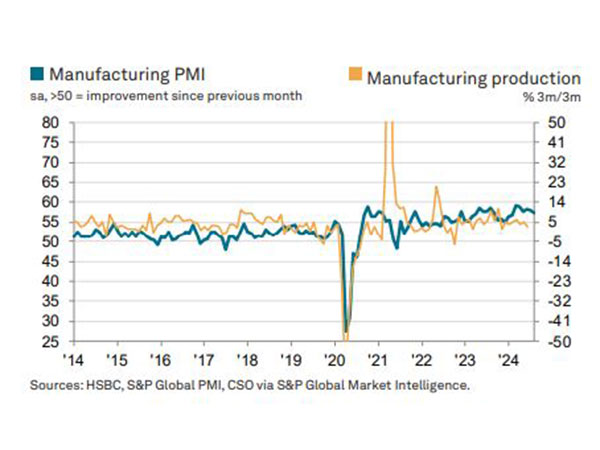India's Manufacturing PMI Reflects Modest Slowdown but Robust Growth in August
India's Manufacturing PMI fell slightly to 57.5 in August from 58.1 in July. Despite the dip, it remains above the long-term average of 54.0, affirming solid growth in operating conditions. Manufacturers saw a moderation in new business and output growth but increased purchasing to buffer against input shortages.

- Country:
- India
India's Manufacturing Purchasing Managers' Index (PMI) witnessed a minor decline in August, slipping to 57.5 from 58.1 in July, revealed the HSBC India Manufacturing PMI report. Despite the decrease, August's PMI remains significantly above the long-term average of 54.0, signaling substantial improvement in operational conditions.
The report highlighted softer increases in new business and output during August, although these growth rates were robust by historical standards. "The seasonally adjusted HSBC India Manufacturing Purchasing Managers' Index™ (PMI®) stood at 57.5 in August, below July's reading of 58.1 but above its long-term average of 54.0, indicating a significant enhancement in operating conditions," the report stated.
Business confidence saw a dip; however, firms increased purchasing activity to mitigate potential input shortages, resulting in a remarkable rise in pre-production inventories. This trend marked one of the most substantial upturns in nearly two decades. The moderation in cost pressures, with input price inflation hitting its lowest level in five months, supported the rise in purchasing activity. Firms passed on additional costs to customers amid resilient demand, leading to higher selling prices.
"The Indian manufacturing sector continued its expansion in August, albeit at a slightly moderated pace. New orders and output paralleled the headline trend, with some panelists attributing the slowdown to fierce competition," said Pranjul Bhandari, Chief India Economist at HSBC. New business saw a significant rise but slowed to a seven-month low. Growth was driven by advertising, brand recognition, and healthy demand trends, though competitive conditions tempered this expansion.
New export orders increased at the slowest rate since early 2024, with improved international sales predominantly reported in Asia, Africa, Europe, and the US. The easing of cost pressures provided relief to goods producers, with purchase prices climbing at the slowest pace in five months. Firms noted higher costs for leather, minerals, and rubber.
As input cost inflation receded, manufacturers focused on rebuilding safety stocks by purchasing additional raw materials and semi-finished goods, leading to the sharpest input buying growth since April. August saw a significant rise in input inventories, reaching near two-decade highs. The absence of pressure on supplier capacity aided stock-building efforts, with input lead times shortening for the sixth consecutive month.
Work backlogs remained stable from July, and job creation softened as some firms reduced headcounts. However, overall employment growth was solid compared to historical data. "Job creation softened midway through the second fiscal quarter as a few firms trimmed headcounts," the report added.
Despite the easing cost pressures, the prices of Indian goods saw a notable rise in August, with inflation hitting the second-fastest rate in nearly 11 years. Firms passed on additional cost burdens to clients amid strong demand. (ANI)
(With inputs from agencies.)










